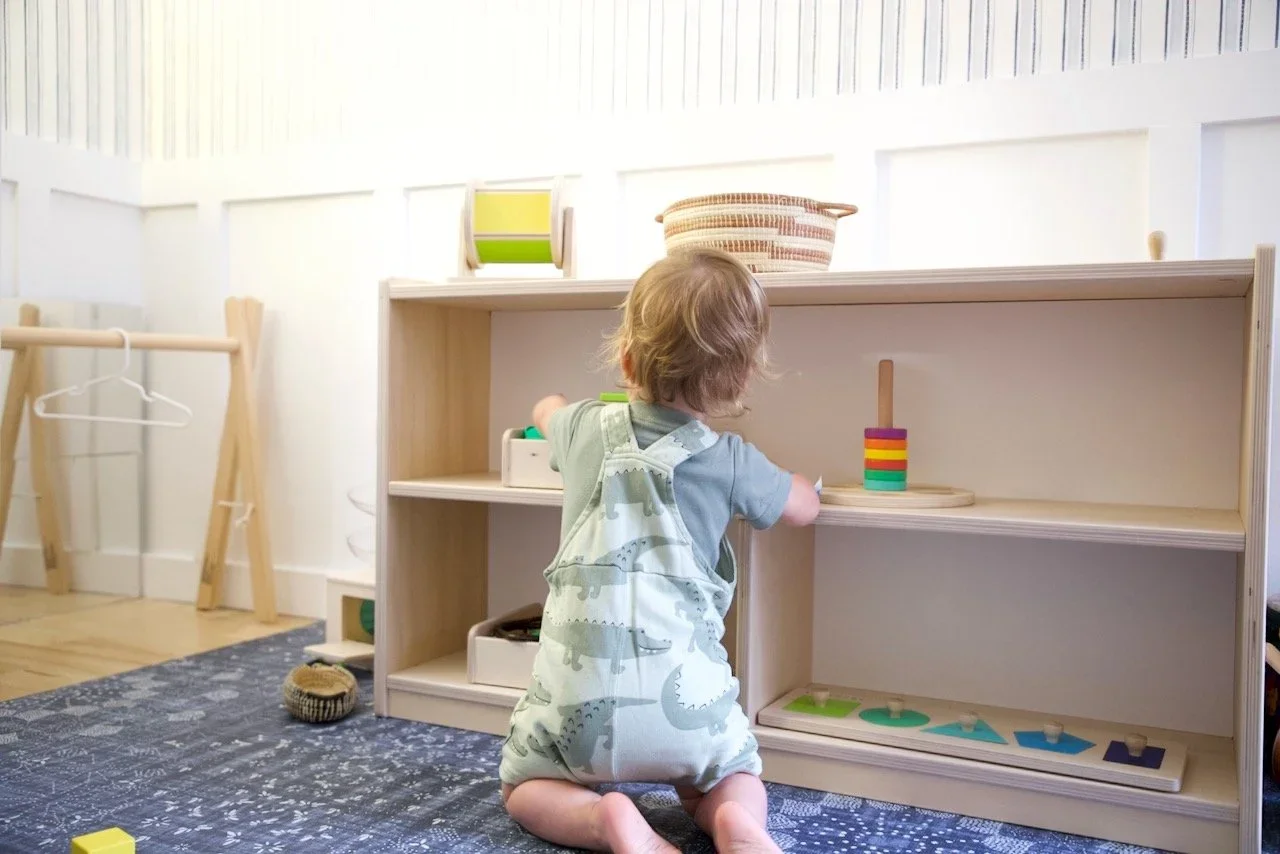Why We Love Open Shelving for Kids (And Why Your Children Will Too)
Picture this: your child walks into their room and immediately spots their favorite puzzle on the shelf. No digging through toy boxes, no asking for help reaching something in a closed cabinet, no frustrated sighs when they can't find what they're looking for. They simply walk over, grab it, and dive into an hour of focused play.
This isn't a fantasy—it's the everyday reality of open shelving done right. While closed storage has its place in children's spaces, there's something magical about open shelving that transforms how kids interact with their belongings and, more importantly, how independently they can navigate their world.
If you've been on the fence about incorporating open shelving into your child's space, let us share why we're completely smitten with this approach—and why your family might be too.
Independence Starts with "I Can See It"
There's a reason the Montessori method emphasizes open, accessible storage: children naturally gravitate toward what they can see. When toys, books, and materials are displayed openly at child height, something wonderful happens. Kids stop asking for help finding things, stop getting frustrated when they can't locate their favorite items, and start making choices about what they want to do based on what catches their eye.
Think about your own experience in a well-organized kitchen. You can quickly scan your spice rack and grab exactly what you need without opening every single cabinet door. Open shelving works the same way for children, but the benefits go far beyond convenience. When kids can see their options, they become active decision-makers in their own play experiences rather than passive recipients of whatever adults retrieve for them.
This visual accessibility also means children are more likely to put things back where they belong. When everything has a clear, visible home, cleanup becomes intuitive rather than confusing. No more wondering which bin the blocks belong in or where the art supplies should go.
The Beauty of Natural Organization
One of the most surprising benefits of open shelving is how it naturally encourages organization—not just from parents, but from children themselves. When everything is on display, both kids and adults become more mindful about what stays and what goes.
Open shelving acts as a gentle editor for your child's belongings. You quickly notice when shelves become overcrowded or when certain toys haven't been touched in months. This visibility makes it easier to rotate toys, donate items that have been outgrown, and maintain that sweet spot of having enough choices without overwhelming your child.
Children also develop a better sense of spatial awareness when they can see how their belongings fit into their space. They start to understand concepts like "this shelf is getting too full" or "maybe I should put this back before getting something else out." These are valuable life skills disguised as simple tidying habits.
Creating Displays That Inspire Play
Here's where open shelving gets really exciting: it transforms storage into inspiration. When you thoughtfully arrange books, toys, and materials on open shelves, you're creating little vignettes that spark ideas and invite interaction.
A shelf might feature a few favorite books alongside some building blocks and a small plant, creating a cozy reading nook that naturally encourages quiet time. Another shelf could display art supplies next to a small basket of natural materials like pinecones and smooth stones, inspiring creative projects that blend indoor and outdoor elements.
The key is curation over accumulation. Instead of cramming every single toy onto the shelves, choose a rotating selection that represents different types of play: building, creating, reading, and imagining. This approach keeps the space feeling fresh and prevents that overwhelming "toy store explosion" look that can actually inhibit play rather than encourage it.
Safety and Accessibility Hand in Hand
One concern many parents have about open shelving is safety, but when done thoughtfully, open shelving can actually be safer than traditional closed storage. Children aren't climbing on chairs to reach high cabinets or struggling with heavy toy box lids that could slam shut on little fingers.
The trick is designing with your child's current abilities in mind while building in room for growth. Shelves should be low enough for independent access but high enough that crawling babies can't reach inappropriate items. As children grow, you can gradually move items to higher shelves, naturally expanding their accessible storage space.
Consider the weight and fragility of items you display openly. Heavier books can go on lower shelves where they're easier to handle, while lighter items can live higher up. Breakable items might be better suited for closed storage until children develop better handling skills, and that's perfectly fine. The goal is creating a space where children can succeed, not one where they're constantly being told "don't touch."
The Long Game of Learning
Open shelving teaches children valuable lessons that extend far beyond keeping their rooms tidy. When kids can see their belongings and access them independently, they develop better decision-making skills, stronger visual memory, and a sense of ownership over their environment.
These skills translate into academic settings too. Children who are used to scanning shelves for what they need often become better at organizing their school supplies, locating materials in the classroom, and keeping track of their belongings. They understand that organization isn't about perfection—it's about creating systems that work for real life.
There's also something to be said for the confidence that comes with independence. When children can successfully find, use, and return their belongings without adult intervention, they develop a sense of competence that influences how they approach other challenges in their lives.
Making It Work in Real Life
The beauty of open shelving lies in its adaptability. You don't need a dedicated playroom or custom built-ins to make it work. A simple bookshelf in a bedroom corner, floating shelves in a hallway, or even a low console in the living room can become effective open storage for children's belongings.
Start small and see how your family responds. You might begin with just books on open shelves, then gradually add toys, art supplies, or other materials as you see what works for your space and your children's habits. Remember that open shelving is most effective when it's not overcrowded, so resist the urge to fill every inch of shelf space.
Consider your family's lifestyle too. If you prefer a more minimalist look, open shelving might showcase just a few carefully chosen items. If your children thrive with more visual stimulation, you might fill shelves more generously while still maintaining organization and accessibility.
Beyond Storage: Creating Connection
Perhaps the most wonderful thing about open shelving is how it creates opportunities for connection. When children's belongings are beautifully displayed and easily accessible, parents find themselves naturally drawn into conversations about what their kids are interested in, what they're learning, and what they might want to explore next.
A shelf displaying your child's latest art project, a book they've been reading repeatedly, and a collection of interesting rocks becomes a story about who they are right now. These visible collections of childhood spark memories, conversations, and connections that might never happen if everything were hidden away in bins and boxes.
Open shelving also makes it easier for children to share their interests with friends and family. When everything is visible and accessible, kids become natural tour guides of their own spaces, proudly showing off their favorite things and explaining why certain items are special to them.
The result is storage that does so much more than just organize belongings—it celebrates childhood, encourages independence, and creates a foundation for lifelong organizational skills. And really, what more could we ask for from a simple shelf?
How has open shelving worked in your family's space? We'd love to hear about your successes and creative solutions in the comments!
Looking for beautiful, durable shelving that grows with your child? Explore our collection of solid wood storage solutions designed to support independence and inspire organization at www.alderbourn.com.

